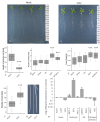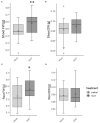Novel Pseudomonas sp. SCA7 Promotes Plant Growth in Two Plant Families and Induces Systemic Resistance in Arabidopsis thaliana
- PMID: 35875540
- PMCID: PMC9297469
- DOI: 10.3389/fmicb.2022.923515
Novel Pseudomonas sp. SCA7 Promotes Plant Growth in Two Plant Families and Induces Systemic Resistance in Arabidopsis thaliana
Abstract
Pseudomonas sp. SCA7, characterized in this study, was isolated from roots of the bread wheat Triticum aestivum. Sequencing and annotation of the complete SCA7 genome revealed that it represents a potential new Pseudomonas sp. with a remarkable repertoire of plant beneficial functions. In vitro and in planta experiments with the reference dicot plant A. thaliana and the original monocot host T. aestivum were conducted to identify the functional properties of SCA7. The isolate was able to colonize roots, modify root architecture, and promote growth in A. thaliana. Moreover, the isolate increased plant fresh weight in T. aestivum under unchallenged conditions. Gene expression analysis of SCA7-inoculated A. thaliana indicated a role of SCA7 in nutrient uptake and priming of plants. Moreover, confrontational assays of SCA7 with fungal and bacterial plant pathogens revealed growth restriction of the pathogens by SCA7 in direct as well as indirect contact. The latter indicated involvement of microbial volatile organic compounds (mVOCs) in this interaction. Gas chromatography-mass spectrometry (GC-MS) analyses revealed 1-undecene as the major mVOC, and octanal and 1,4-undecadiene as minor abundant compounds in the emission pattern of SCA7. Additionally, SCA7 enhanced resistance of A. thaliana against infection with the plant pathogen Pseudomonas syringae pv. tomato DC3000. In line with these results, SA- and JA/ET-related gene expression in A. thaliana during infection with Pst DC3000 was upregulated upon treatment with SCA7, indicating the ability of SCA7 to induce systemic resistance. The thorough characterization of the novel Pseudomonas sp. SCA7 showed a remarkable genomic and functional potential of plant beneficial traits, rendering it a promising candidate for application as a biocontrol or a biostimulation agent.
Keywords: Arabidopsis thaliana; ISR; PGPB; Pseudomonas; Triticum aestivum L.; biocontrol; mVOCs; plant-microbe interactions.
Copyright © 2022 Kuhl-Nagel, Rodriguez, Gantner, Chowdhury, Schwehn, Rosenkranz, Weber, Schnitzler, Kublik, Schloter, Rothballer and Falter-Braun.
Conflict of interest statement
TK-N, PR, IS, SP, PS, MR, BW, J-PS, SK, MS, MR, and PF-B were employed by Helmholtz Center Munich, German Research Center for Environmental Health.
Figures









Similar articles
-
Priming of camalexin accumulation in induced systemic resistance by beneficial bacteria against Botrytis cinerea and Pseudomonas syringae pv. tomato DC3000.J Exp Bot. 2022 Jun 2;73(11):3743-3757. doi: 10.1093/jxb/erac070. J Exp Bot. 2022. PMID: 35191984
-
Systemic resistance induced by volatile organic compounds emitted by plant growth-promoting fungi in Arabidopsis thaliana.PLoS One. 2014 Jan 27;9(1):e86882. doi: 10.1371/journal.pone.0086882. eCollection 2014. PLoS One. 2014. PMID: 24475190 Free PMC article.
-
Rhizosphere-associated Pseudomonas induce systemic resistance to herbivores at the cost of susceptibility to bacterial pathogens.Mol Ecol. 2018 Apr;27(8):1833-1847. doi: 10.1111/mec.14400. Epub 2017 Nov 23. Mol Ecol. 2018. PMID: 29087012
-
Induction of systemic resistance in Arabidopsis thaliana in response to a culture filtrate from a plant growth-promoting fungus, Phoma sp. GS8-3.Plant Biol (Stuttg). 2009 Jan;11(1):97-104. doi: 10.1111/j.1438-8677.2008.00142.x. Plant Biol (Stuttg). 2009. PMID: 19121119
-
Transcription factor MYC2 is involved in priming for enhanced defense during rhizobacteria-induced systemic resistance in Arabidopsis thaliana.New Phytol. 2008;180(2):511-523. doi: 10.1111/j.1469-8137.2008.02578.x. Epub 2008 Jul 24. New Phytol. 2008. PMID: 18657213
Cited by
-
Exploring Endophytic Bacteria from Artemisia spp. and Beneficial Traits on Pea Plants.Plants (Basel). 2024 Jun 18;13(12):1684. doi: 10.3390/plants13121684. Plants (Basel). 2024. PMID: 38931116 Free PMC article.
-
Unveiling the multifaceted potential of Pseudomonas khavaziana strain SR9: a promising biocontrol agent for wheat crown rot.Microbiol Spectr. 2024 Oct 3;12(10):e0071224. doi: 10.1128/spectrum.00712-24. Epub 2024 Aug 20. Microbiol Spectr. 2024. PMID: 39162535 Free PMC article.
-
Complete genome sequence of Pseudomonas sp. HT11 isolated from broad bean (Vicia faba L.).Curr Genet. 2025 Feb 12;71(1):6. doi: 10.1007/s00294-025-01310-3. Curr Genet. 2025. PMID: 39937297
-
Polychlorinated biphenyls modify Arabidopsis root exudation pattern to accommodate degrading bacteria, showing strain and functional trait specificity.Front Plant Sci. 2024 Jul 5;15:1429096. doi: 10.3389/fpls.2024.1429096. eCollection 2024. Front Plant Sci. 2024. PMID: 39036359 Free PMC article.
References
-
- Alquéres S., Meneses C., Rouws L., Rothballer M., Baldani I., Schmid M., et al. (2013). The bacterial superoxide dismutase and glutathione reductase are crucial for endophytic colonization of rice roots by Gluconacetobacter diazotrophicus PAL5. MPMI. 26, 937–945. 10.1094/MPMI-12-12-0286-R - DOI - PubMed
LinkOut - more resources
Full Text Sources
Molecular Biology Databases
Miscellaneous

